Related Research Articles

Fighter aircraft are military aircraft designed primarily for air-to-air combat. In military conflict, the role of fighter aircraft is to establish air superiority of the battlespace. Domination of the airspace above a battlefield permits bombers and attack aircraft to engage in tactical and strategic bombing of enemy targets.

A military aircraft is any fixed-wing or rotary-wing aircraft that is operated by a legal or insurrectionary military of any type. Military aircraft can be either combat or non-combat:

The Mikoyan-Gurevich MiG-21 is a supersonic jet fighter and interceptor aircraft, designed by the Mikoyan-Gurevich Design Bureau in the Soviet Union. Its nicknames include: "Balalaika", because its planform resembles the stringed musical instrument of the same name; "Ołówek", Polish for "pencil", due to the shape of its fuselage, and "Én Bạc", meaning "silver swallow", in Vietnamese.

John Richard Boyd was a United States Air Force fighter pilot and Pentagon consultant during the second half of the 20th century. His theories have been highly influential in military, business, and litigation strategies and planning.
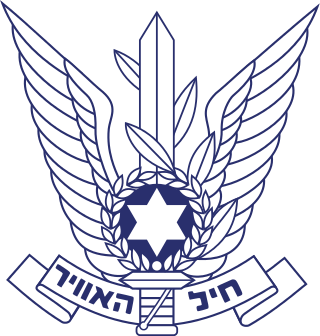
The Israeli Air Force operates as the aerial and space warfare branch of the Israel Defense Forces (IDF). It was founded on May 28, 1948, shortly after the Israeli Declaration of Independence. As of April 2022, Aluf Tomer Bar has been serving as the Air Force commander.

The Mikoyan-Gurevich MiG-23 is a variable-geometry fighter aircraft, designed by the Mikoyan-Gurevich design bureau in the Soviet Union. It is a third-generation jet fighter, alongside similar Soviet aircraft such as the Su-17 "Fitter". It was the first Soviet fighter to field a look-down/shoot-down radar, the RP-23 Sapfir, and one of the first to be armed with beyond-visual-range missiles. Production started in 1969 and reached large numbers with over 5,000 aircraft built, making it the most produced variable-sweep wing aircraft in history. The MiG-23 remains in limited service with some export customers.

Aerial warfare is the use of military aircraft and other flying machines in warfare. Aerial warfare includes bombers attacking enemy installations or a concentration of enemy troops or strategic targets; fighter aircraft battling for control of airspace; attack aircraft engaging in close air support against ground targets; naval aviation flying against sea and nearby land targets; gliders, helicopters and other aircraft to carry airborne forces such as paratroopers; aerial refueling tankers to extend operation time or range; and military transport aircraft to move cargo and personnel.
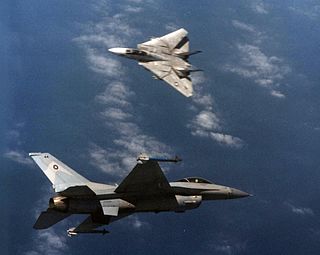
A dogfight, or dog fight, is an aerial battle between fighter aircraft conducted at close range. Modern terminology for air-to-air combat is air combat manoeuvring (ACM), which refers to tactical situations requiring the use of individual basic fighter maneuvers (BFM) to attack or evade one or more opponents. This differs from aerial warfare, which deals with the strategy involved in planning and executing various missions.

A flying ace, fighter ace or air ace is a military aviator credited with shooting down five or more enemy aircraft during aerial combat. The exact number of aerial victories required to officially qualify as an ace is varied but is usually considered to be five or more.
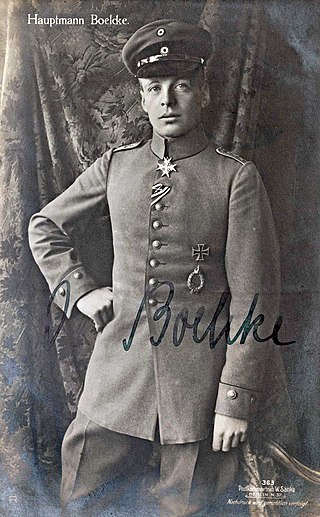
The Dicta Boelcke is a list of fundamental aerial maneuvers of aerial combat formulated by First World War German flying ace Oswald Boelcke. Equipped with one of the first fighter aircraft, Boelcke became Germany's foremost flying ace during 1915 and 1916. Because of his success in aerial combat and analytic mind, he was tasked by Colonel Hermann von der Lieth-Thomsen with writing a pamphlet on aerial tactics.

Aerial supremacy is the degree to which a side in a conflict holds control of air power over opposing forces. There are levels of control of the air in aerial warfare. Control of the air is the aerial equivalent of command of the sea.

World War I was the first major conflict involving the large-scale use of aircraft. Tethered observation balloons had already been employed in several wars and would be used extensively for artillery spotting. Germany employed Zeppelins for reconnaissance over the North Sea and Baltic and also for strategic bombing raids over Britain and the Eastern Front.
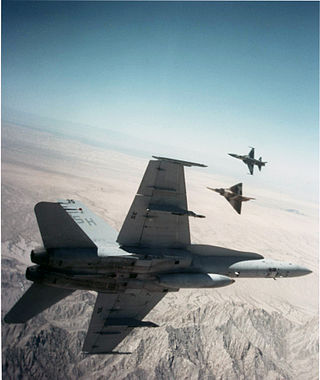
Air combat manoeuvring (ACM) is the tactic of moving, turning, and situating one's fighter aircraft in order to attain a position from which an attack can be made on another aircraft. Commonly associated with dogfighting, air combat manoeuvres rely on offensive and defensive basic fighter manoeuvring (BFM) to gain an advantage over an aerial opponent.

Basic fighter maneuvers (BFM) are tactical movements performed by fighter aircraft during air combat maneuvering, to gain a positional advantage over the opponent. BFM combines the fundamentals of aerodynamic flight and the geometry of pursuit, with the physics of managing the aircraft's energy-to-mass ratio, called its specific energy.
The scissors is an aerial dogfighting maneuver commonly used by military fighter pilots. It is primarily a defensive maneuver, used by an aircraft that is under attack. It consists of a series of short turns towards the attacking aircraft, slowing with each turn, in the hopes of forcing the attacker to overshoot. Performed properly, it can cause the attacking aircraft to move far enough in front to allow the defender to turn the tables and attack.

Dissimilar air combat training (DACT) was introduced as a formal part of US air combat training after disappointing aerial combat exchange rates in the Vietnam War.

The Yemeni Air Force is the air operations branch of the Yemeni Armed Forces. Numbers of aircraft can not be confirmed but serviceability of these aircraft is low. Aircraft have been acquired by donations from other countries supporting either the Soviet Union or the United States during the Cold War. However, most of the air force was destroyed by airstrikes during the Saudi Arabian-led intervention in Yemen.
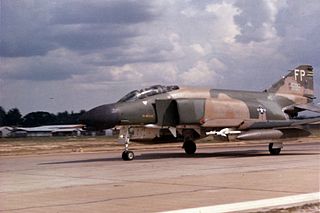
Operation Bolo was a United States Air Force mission during the Vietnam War, considered to be a successful combat ruse.

During World War I, the national air services involved developed their own methods of assessing and assigning credit for aerial victories.
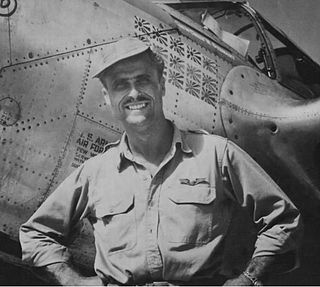
Robert Burdette Westbrook was a United States Army Air Forces lieutenant colonel and a World War II flying ace. Westbrook commanded the 44th Fighter Squadron, and became the leading fighter ace of the Thirteenth Air Force. He is also the ninth ranking fighter ace in the Pacific during World War II and also one of ten United States Army Air Forces pilots who became an ace in two different types of fighter aircraft.
References
- Shaw, Robert L. (Comm.), Fighter Combat: Tactics and Maneuvering, Naval Institute Press, Annapolis, 1985